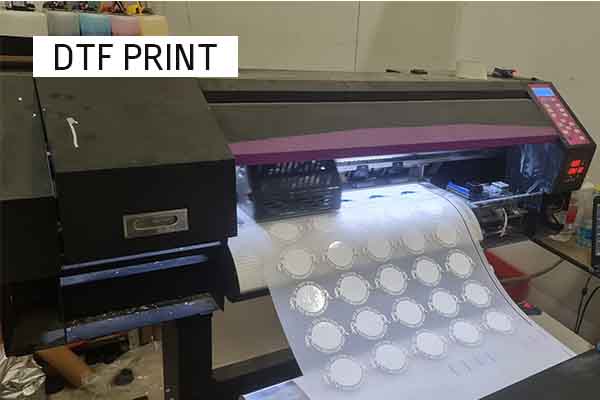Ultimate Guide to DTF Printing Methods for Magnificent Textile Designs
Getting started on the journey of mastering DTF printing strategies can open up a globe of possibilities for creating aesthetically fascinating textile styles. In this guide, we will certainly discover the elaborate information of DTF printing, from grasping the essential basics to unraveling advanced shade strategies that can boost your designs to brand-new heights.
Recognizing DTF Printing Essentials
DTF printing, a procedure that involves moving layouts from a special movie to textiles using heat and stress, develops the foundation of fabric printing techniques. This ingenious technique permits premium, vibrant layouts to be effortlessly moved onto numerous textiles with accuracy and information. The very first step in DTF printing involves developing or choosing a design that will certainly be published onto the fabric. This style is then published onto an unique movie using a DTF printer, which makes use of certain dyes or pigments to guarantee shade accuracy and sturdiness.
The final outcome is a spectacular, resilient fabric design that is washable, adaptable, and immune to fading. In general, understanding the fundamentals of DTF printing is important for grasping this contemporary fabric printing method.
Picking the Right Textile Products
Having actually established the foundational concepts of DTF printing techniques for fabric designs, the next crucial factor to consider lies in selecting the proper textile materials to enhance this innovative procedure properly. Additionally, the stretchability of these materials can accommodate the warmth transfer process involved in DTF printing without misshaping the design. By choosing the right fabric products, designers can maximize the capacity of DTF printing to create spectacular and lasting fabric layouts.

Mastering the Printing Refine
To master DTF printing techniques for textile styles, grasping the printing process is vital for achieving constant and top notch outcomes. The printing process in DTF entails a number of essential actions that need precision and interest to information. Preparing the artwork for printing is crucial. This consists of making sure the style is appropriately sized and placed for the textile. Next off, the style is published onto a special DTF film utilizing a suitable printer with the appropriate setups to attain optimum shade vibrancy and clarity (DTF Printing). Once the style is published, it is after that moved onto the fabric utilizing a warm press maker. The temperature level, pressure, and period of warm application should be carefully managed to make sure proper bond of the design to the fabric. Additionally, mastering the peeling procedure after heat pushing is vital to prevent any damages to the style or textile. By sharpening each of these action in the printing process, designers can continually generate sturdy and magnificent fabric designs with DTF printing techniques.
Enhancing Designs With Shade Methods

Moreover, try out shade slopes can bring a sense of motion and fluidity to the design. By blending shades perfectly, a gradient impact can be achieved, adding a dynamic and contemporary touch to the textile layout. In addition, making use of color blocking strategies can produce vibrant and striking visuals by comparing various solid colors in distinctive sections of the layout.
Furthermore, incorporating metallic or neon shades can offer a captivating and one-of-a-kind aspect to the fabric design, making it stick out and exhibit a sense of vibrancy. When strategically applied, these shade techniques can boost the overall aesthetic charm of fabric styles, making them much more memorable and fascinating.
Troubleshooting Common DTF Printing Issues
After checking out various color methods to improve textile styles, it is vital to resolve usual DTF printing concerns that may emerge throughout the manufacturing process. One usual problem is poor attachment, which can result from inappropriate healing temperature levels or times. To fix these details this issue, make certain that the curing settings are exact which the glue used is suitable for the details material why not try these out being published on. An additional frequent obstacle is shade disparities, where shades might show up in different ways than anticipated. This can be brought on by wrong color profiles or setups in the printing software program. To tackle this, verify the color settings and profiles to guarantee they match the designated design. Additionally, concerns with photo clearness and sharpness can occur because of low-resolution images or improper printing techniques. To resolve this, always make use of premium pictures and readjust the printing settings for optimal clarity. By knowing these usual problems and executing the needed troubleshooting steps, you can boost the overall top quality of your DTF published textile styles.
Verdict
In final thought, understanding DTF printing methods is necessary for producing spectacular textile layouts. With method and focus to detail, one can develop lovely and distinct fabric layouts utilizing DTF printing techniques.
Styles))))
DTF printing, a process that includes moving styles from a special movie to textiles utilizing heat and stress, forms the structure of fabric printing strategies.Having actually established the fundamental concepts of DTF printing techniques for fabric styles, the following critical factor to consider exists in picking the proper textile materials to enhance this ingenious procedure efficiently. By selecting the best fabric materials, developers can take full advantage of the possibility of DTF printing to create long-lasting and magnificent textile designs.
To excel in DTF printing techniques for fabric layouts, grasping the printing process is vital for attaining regular and premium results. DTF Printing. By honing each of these actions in the printing process, designers can consistently generate magnificent and sturdy fabric designs with DTF printing techniques